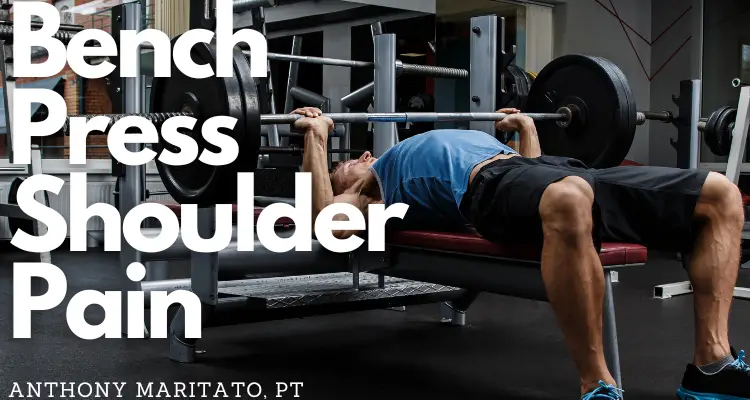Bench Press With Shoulder Pain: A Comprehensive Guide
I have been a physical therapist since 2006 and a certified strength coach since 2001. If there is one thing I have learned over the past 22 years it is that pain does not always mean danger or damage.
A simple rule of thumb for guiding your decision to stop an exercise or activity due to pain is this: “If it hurts more as you continue then stop. If it hurts at first, but then feels better as you keep going then continue.” – Tony Maritato, PT

Is it Safe to Bench Press With Shoulder Pain?
The question of whether it’s safe to bench press with shoulder pain is not straightforward. It largely depends on the nature and intensity of the pain, and your body’s response to the exercise. While pain is an inherent part of the physical exertion involved in many forms of exercise, it’s essential to distinguish between ‘good’ pain and ‘bad’ pain.
‘Good’ pain, often referred to as the ‘burn,’ is the discomfort that comes from the fatigue of your muscles during an intense workout. This type of pain is typically short-lived and subsides once the exercise is over. On the other hand, ‘bad’ pain often points to an underlying issue that needs attention. It could be due to improper technique, overuse of the muscle, or an injury.
When it comes to bench pressing with shoulder pain, here’s what you should consider:
- Does the pain worsen with every repetition? A little discomfort when you first start is not unusual. However, if the pain intensifies with each rep, it’s a sign that you should stop. Increasing pain can indicate that you’re causing further damage to your shoulder.
- Does the pain lead to a decline in your performance? If shoulder pain is compromising your form or preventing you from completing your reps, it’s time to pause. Performing exercises with improper form can lead to injuries.
- Does the pain persist or increase the next day? Some post-workout soreness is normal, known as DOMS (Delayed Onset Muscle Soreness). But if the pain increases or is significantly worse the next day, it suggests that you may have strained or injured your shoulder. In such cases, seek medical advice.
On the flip side, if your shoulder pain is reduced or eliminated as you continue the bench press exercise, it may be safe to proceed. This could simply be your muscles warming up and adapting to the strain. However, this does not mean you should ignore the pain entirely. Always listen to your body and maintain proper form throughout the exercise.
Remember, working through severe pain is not a testament to your strength. In fact, it can lead to serious injuries that could sideline your training for weeks, or even months. It’s essential to strike a balance between pushing your limits and preserving your health and safety.
In conclusion, bench pressing with shoulder pain can be safe, provided the pain is monitored closely, and appropriate measures are taken when it escalates. Fitness is a long-term goal and it’s crucial to prioritize sustainability over temporary gains.

When Should I Stop Bench Pressing With Shoulder Pain?
Knowing when to stop and when to push through is crucial to maintain an effective and safe workout routine. When it comes to bench pressing with shoulder pain, it’s especially important to understand your body’s signals. The type, intensity, and duration of pain can provide vital information about your physical condition and inform your decisions about when to stop and when to continue.
When to Stop
While a certain amount of discomfort can be part of a strenuous workout, there are definite signs when it’s time to stop:
- Pain intensifies with each repetition: If you notice a progressive increase in pain with every bench press, it’s time to halt your workout. This escalating pain could indicate potential harm to your shoulder.
- Persistent or worsening pain: If you experience pain that doesn’t decrease over time, or it worsens after your workout and into the next day, it’s crucial to stop and seek medical advice. Persistent pain could be a symptom of an injury.
- Decreased performance or altered form: If pain is causing you to alter your bench press form or limit your range of motion, it’s advisable to stop. Continuing with incorrect form could result in further injury.
When to Continue
There are also circumstances when it’s safe to continue bench pressing, even with some shoulder discomfort:
- Pain reduces as you warm up: If the pain lessens or disappears as you continue your workout, it might be safe to carry on. This could be a sign that your muscles are warming up and adjusting to the strain of the exercise.
- Mild discomfort that doesn’t worsen: Some discomfort is normal during intense exercise. If the discomfort remains constant and doesn’t escalate into pain, it’s generally safe to continue.
- Pain that doesn’t affect performance: If the discomfort doesn’t interfere with your form or the number of reps, and doesn’t intensify, it might be safe to keep going. But remember, always keep a close watch on the pain.
Always remember to listen to your body and respect its limits. You should never ignore pain. Instead, try to understand its source and adjust your workout accordingly. There’s no shame in stopping a workout early to prevent injury. Remember, it’s better to take a short break now than to be forced to take a long one later due to injury.
How Can I Change the Bench Press to Avoid Shoulder Pain?
Experiencing shoulder pain during a bench press can be an indication that a modification is necessary. Altering your technique or approach to the exercise can help reduce discomfort and enhance your performance. Here are four practical ways to modify the bench press to avoid shoulder pain:
1. Decrease Load and Increase Reps
If you’re experiencing shoulder pain while bench pressing, consider reducing the weight you’re lifting. Heavy loads can put excessive stress on your shoulder joints, leading to discomfort and potential injury. Instead of lifting heavy, try decreasing the load and increasing the number of reps. This method can help maintain muscle endurance and strength, while reducing the risk of injury.
2. Change Hand Position
Your hand position on the barbell can significantly impact the strain placed on your shoulder joints. A wide grip can put additional stress on the shoulders, while a narrow grip focuses more on the triceps. Experiment with adjusting your grip. Remember, a comfortable grip is essential, and it’s important not to compromise your form. It may be beneficial to seek guidance from a trainer to find the most suitable hand position for your body and goals.
3. Seek Professional Assessment
Having a professional assess your bench press technique can provide valuable insights into why you’re experiencing shoulder pain. A personal trainer or physiotherapist can identify any flaws in your technique that could be contributing to your discomfort. They can offer advice on correcting your form, improving your lifting technique, and making the most of your workout without causing unnecessary harm to your body.
4. Ensure Proper Recovery
Rest and recovery are crucial components of any workout regimen. Without adequate recovery time, muscles and joints can become overworked, leading to increased discomfort and risk of injury. Ensure you’re giving your body ample time to recover between workouts. This includes getting quality sleep, eating a balanced diet, staying hydrated, and considering practices like stretching, massage, or yoga to aid in recovery and maintain flexibility.
In conclusion, modifying your bench press routine doesn’t mean you’re compromising on your fitness goals. Instead, it means you’re listening to your body and taking the necessary steps to achieve those goals sustainably and safely. Remember, consistency trumps intensity when it comes to long-term results.
What Could Be Causing the Shoulder Pain?
Shoulder pain during a bench press can be caused by a variety of factors. Understanding the potential causes can help you adjust your technique or seek appropriate treatment. The shoulder joint is a complex structure, formed by the clavicle (collarbone), scapula (shoulder blade), and humerus (upper arm bone). It’s held together and supported by muscles, tendons, and ligaments that can all be sources of pain.
Here are some potential causes of shoulder pain during bench pressing:
1. Rotator Cuff Injury
The rotator cuff is a group of muscles and tendons that stabilize the shoulder joint, allowing you to lift and rotate your arm. Overuse or straining these tissues during exercises like the bench press can result in rotator cuff injuries, leading to pain and decreased range of motion.
2. Shoulder Impingement
Shoulder impingement occurs when the top of the shoulder blade puts pressure on the underlying soft tissues, like the rotator cuff tendons and bursa, especially when you lift your arm. If your bench press form involves an inappropriate arm angle, it might contribute to this condition, causing pain and inflammation.
3. Poor Technique
Performing the bench press with incorrect form can place undue stress on the shoulder joint and surrounding tissues. This includes using a grip that’s too wide or too narrow, not keeping your feet flat on the floor, or lifting a load that’s too heavy.
4. Lack of Mobility
Shoulder mobility is essential for executing a correct and safe bench press. If you lack the necessary flexibility, it can place additional strain on your shoulder joint, leading to discomfort or injury.
If you’re experiencing persistent shoulder pain during or after bench pressing, it’s important to seek professional advice. A physical therapist or medical professional can help identify the cause of the pain and recommend appropriate modifications or treatments. Always remember that safety and sustainability should be at the forefront of your fitness journey.
What Can I Do Instead of a Bench Press to Continue Building Strength?
If bench pressing causes shoulder pain, there are still plenty of exercises that can effectively strengthen your chest and triceps without exacerbating your discomfort. It’s crucial to find alternatives that work for your unique circumstances and continue your journey towards building strength. Below is a table listing five alternative exercises, along with brief descriptions of each:
| Exercise | Description |
|---|---|
| Dumbbell Chest Press | This exercise targets the same muscles as the bench press, but the use of dumbbells can provide a greater range of motion, allowing for a more natural movement pattern and less stress on the shoulders. |
| Push-ups | Push-ups are a great bodyweight exercise that can strengthen your chest, triceps, and shoulders. They can be modified to decrease stress on the shoulders, such as performing them on your knees or against a wall. |
| Standing Cable Chest Press | Performing a chest press on a cable machine allows for a dynamic movement that strengthens your chest and triceps. It also promotes stabilization from your core and lower body. |
| Dips | Dips are an excellent exercise for targeting the chest and triceps. They can be performed on parallel bars or even on a bench. Ensure to maintain proper form to avoid putting unnecessary stress on your shoulders. |
| Pec Deck Machine | This machine exercise isolates the chest muscles without placing much stress on the shoulders. It’s an excellent alternative for those who wish to strengthen their chest muscles while protecting their shoulders. |
Remember, every exercise should be performed with proper form and control to prevent injury. If you’re unsure about the technique, please consider seeking guidance from a professional. Remember to listen to your body and modify or stop the exercise if you experience pain.
Key Takeaways
- Listen to Your Body: While some discomfort during a workout is normal, you should always pay attention to pain signals. If the pain gets worse with each repetition, persists after your workout, or affects your form or performance, it might be a sign to stop and seek professional advice.
- Modifications Can Help: Adjustments such as decreasing load and increasing repetitions, changing your hand position on the barbell, or improving your technique under professional guidance can reduce shoulder pain during bench presses. Also, ensuring proper recovery between workouts is crucial.
- Understand the Causes: Shoulder pain during bench press could be due to factors such as rotator cuff injury, shoulder impingement, poor technique, or lack of mobility. Understanding the cause can guide appropriate modifications or treatments.
- Explore Alternatives: If bench presses cause shoulder pain, there are many other exercises that can help build strength in your chest and triceps. Examples include dumbbell chest press, push-ups, standing cable chest press, dips, and using a pec deck machine.
- Safety and Sustainability: The ultimate goal should be to pursue fitness sustainably and safely. Taking care of your body by listening to it, making necessary adjustments, understanding the causes of pain, and finding alternative exercises can help you maintain progress towards your fitness goals without risking injury.
More Blog Posts
What to Expect the First Week After your Knee Replacement Surgery
Week 1 After Knee Replacement Surgery If your surgery was performed in an outpatient surgery center then you would have likely been discharged to your home the day of surgery. In this article I will be discussing what you need during the first week after total knee...
How to Choose the Best Physical Therapist
There are many factors that go into choosing the best physical therapist for your rehabilitation. One such factor is access. If you are having a total knee replacement you will inevitably have questions about your incision or positioning or any number of other...
9 BEST Gift Ideas for Anyone Having A Total Knee Replacement in 2022
This article includes my favorite list of the 9 Best Gift Ideas for Anyone Having a Total Knee Replacement in 2022. Cyotherapy Moist heat Walker tray/basket Ankle & Calf Massager Rolling Pin Water Bottle Journal Audio Book Membership Meal Delivery Cryotherapy...

Tight Calf Muscle After Knee Replacement
Calf pain after a total knee replacement or other knee surgery if very common. Part of the problem is the swelling, part is weakness in the muscle and part is the dramatic change in activity level.
In this video I explain these three causes of calf pain as well as some solutions we usually recommend in the clinic. After watching this video I will share recommended exercises you can ask your therapist about.
Baker’s Cyst After Knee Replacement
A Baker's cyst resolved in only a small number of patients (15%) one year after TKA and symptoms from the cysts persisted in 31%. Cite this article: Bone Joint J 2016;98-B:1185-8.[1]What is a Baker's Cyst?If you have ever felt that painful swollen lump behind your...
Knee Pain 1 Year After Knee Replacement Surgery
Nearly 20% of patients who have undergone total knee replacement are not happy with the outcome. [1] Dr. Scott Albright, MD. Dr. Albright is a non-surgical orthopedic specialist and in my opion one of the best sports medicine doctors in Middletown, Ohio. He has...

Anthony Maritato, PT
Physical Therapist
Anthony Maritato, PT has been a licensed physical therapist and private practice owner since 2006. Ohio license #PT011602.
Anthony has been passionate about helping patients recover from total knee replacement surgery as well as rotator cuff repair surgery.
